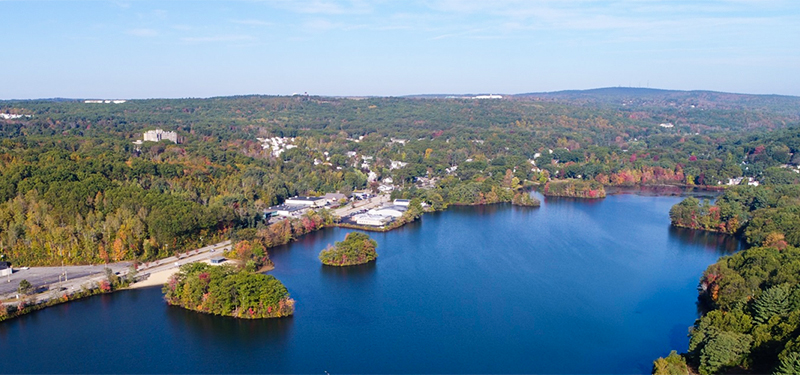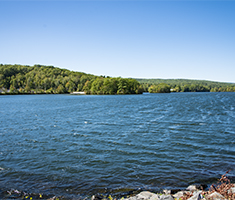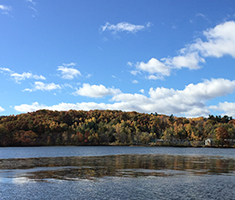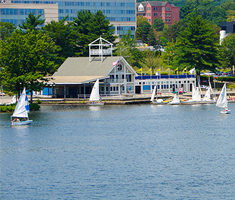
In Worcester, you can find over 20 lakes and ponds that support a variety of recreational activities, including bird watching, walking, swimming, fishing and boating. The City recognizes these "blue spaces" as valuable resources, and strives to maintain the quality of these waters for recreational use and the promotion of economic development. Worcester works with the Commonwealth, watershed groups and other local organization so identify and remediate threats to the quality of our lakes and ponds. We monitor water quality parameters in four of our biggest lakes, work with local scientists and universities to understand the data, create management plans and host educational workshops to help residents better understand the threats to our water quality, and learn how they can improve it.
Learn more about how we work to keep our watersheds healthy on our Green Worcester Dashboard.
Project Blue Worcester
Ensuring that our lakes, ponds and watersheds are healthy for you and for our urban environment means closely monitoring pollutants that can damage the aquatic ecosystem. It also means planning for better ways to keep our blue spaces healthy for generations to come. That's why the Lakes and Ponds Program has launched Project Blue Worcester in 2025. Focusing on three major waterbodies and surrounding land and tributaries - the Tatnuck Brook, Mill Brook and Quinsigamond watersheds - we are identifying the volume of key pollutants, where they come from and how best to restore and protect our precious blue spaces.
Our Top Priority: Reduce Phosphorus Pollutants
Our biggest challenge is managing and reducing the flow of excess nutrients into our waterbodies. In particular, we are focused on identifying phosphorus pollutants such as excess fertilizer as well as sediments from decaying leaves and other organic litter that are carried into streams, rivers, ponds and lakes by rain runoff and snow melt. We are also investigating the impact of harmful bacteria from various sources. Phosphorus pollutants can contribute to overgrowth of cyanobacteria, which can sicken pets, irritate skin and necessitate beach closures. Excessive phosphorus can also accelerate the growth of invasive species, upsetting the intricate aquatic ecosystem and choking out recreational spaces.
A Roadmap for Best-Practices Restoration and Protection
Project Blue Worcester will create a plan with several goals and action steps, including:
- Water quality goals for phosphorus, bacteria and dissolved oxygen;
- Management measures to reduce pollution, such as conceptual designs for stormwater infrastructure improvements that meet or exceed federal and state guidelines;
- Public education to increase awareness and build stakeholder support for blue spaces.
Your Input is Needed!
Many thanks to all who participated in the public meetings in April! Please review the combined Project Blue Workshop Presentation Slides for all three watersheds, as well as the recording of the Mill Brook watershed meeting below.
Project Blue Worcester - Mill Brook Workshop
A recording of the Mill Brook watershed meeting for Project Blue Worcester held on April 15, 2025.
Watch Now!
Winter Drawdown at Indian Lake and Lake Quinsigamond
Starting at the beginning of November, water levels at Indian Lake and Lake Quinsigamond will be lowered to aid in managing aquatic plants. The water will be gradually lowered to expose the near-shore lakebed to ice and freezing temperatures. This is a cost-effective way to prevent the growth of some plant species which can impede recreation.
The Lake Quinsigamond drawdown and other management activities are managed by the Lake Quinsigamond Commission.
Both lakes will be returned to full height over several weeks beginning in March. Planning a project near the water? Some types of projects, such as dock or retaining wall maintenance, require a permit from the Worcester Conservation Commission. Check out the Waterfront Property Permitting Guide or contact planning@worcesterma.gov to learn about the requirements for your specific situation.
Lake Closure Text Alerts
Sign up to receive text message alerts whenever beaches or lakes are closed for normal operations. Alerts will be sent if a beach closes for a bacteria exceedance, for lake cyanobacteria blooms, or for lake treatments that require the closure of the waterbody. Lakes included in this alert system are Indian Lake, Coes Reservoir, Lake Quinsigamond and Bell Pond.
Worcester Lakes and Ponds Map & Guide
Check out the map below to learn about what activities you can do at each of Worcester's public waterbodies!
Water Quality Monitoring Program Results
State of the Lakes Reports are available! Learn about the water quality and projects happening at your local lake below!
Blue Spaces Videos
Watch these videos to learn more about the health, safety and beauty of our lakes and ponds in Worcester.
Worcester Fisheries and Water Quality
Fish are important parts of the aquatic ecosystem, both affecting and impacted by water quality. Over time, fish populations have shifted in our local lakes and ponds. The following is a report that compiles available data on how and why these changes have occurred, synthesizing years of data by MassWildlife, local water quality data and surveys by resident anglers to track how fish populations have shifted, where they are now and why. Below is also a presentation that includes a summary of the report's findings, as well as the steps the Lakes and Ponds Program is taking to make sure our fisheries thrive.
In 2021 there was a collaboration between Tatnuck Brook, Indian Lake and Lake Quinsigamond Watershed Associations, as well as other state and local entities called the Angler Event Series. This was a series of events highlighting the connections between healthy waters and healthy fisheries, celebrating and sharing the unique fishing opportunities Worcester has to offer and bringing the sport of fishing to more people. You can watch the 2021 Angler Series Playlist videos.
Worcester's Water Quality Challenges
Worcester's industrial history, as well as urbanization, poses challenges to maintaining the quality of the water in the City's lakes and ponds. Major threats to our waterways include nutrient loading and invasive aquatic plants.
Nutrient loading is the addition of nutrients to our lakes and ponds. An overabundance of nutrients promote the growth of algae and aquatic plants, which, in excess, can degrade the quality of water, lead to aquatic life dying and difficulty swimming, boating and fishing.
Nutrients enter our lakes in several ways. Runoff during rain events can carry nutrient-rich fertilizers and pet and geese waste into storm sewers or tributaries that empty into our lakes. Malfunctioning septic systems can leach nutrients into adjacent waters and sanitary sewers illegally connected to the storm water system can also contribute to the problem.
Invasive aquatic plants are generally introduced by accident. Seeds or pieces of the plant will hitch a ride on a boat trailer, boots or an animal traveling between waterbodies. These plants can rapidly reproduce and be difficult to eradicate.
Worcester's situation is not unique in the region, and is common to most urban areas. The City has taken proactive steps in the reduction of nutrient and sediment inputs into our waterways, as well as in the management of algae and aquatic plants.

Cyanobacteria Monitoring Collaborative
The WCMC is a group of citizen science volunteers that is working to better understand the diversity of algae and cyanobacteria in Worcester's lakes and ponds.
Links to Watershed Groups
Watershed groups are nonprofit organizations of citizens advocating for our water resources. Check out the below links to learn more about what these organizations are doing to protect our waters:
Major Bodies of Water

Bell Pond
This park is located at the summit of Bell Hill, also known as Chandler Hill Park. It features Bell Hill Pond, formerly known as Bladder Pond, which was Worcester's first reservoir/water supply in 1845.

Coes Pond
The area around Coes Reservoir (or Coes Pond) consists of 20.79 acres and incorporates five properties including the John J. Binienda Memorial Beach, Coes Park, Columbus Park, the former Fenton Parcel and the former Knights of Columbus.

Indian Lake
Indian Lake consists of 193 acres and attracts many visitors each year for a variety of recreational activities including boating, swimming, fishing, ice fishing and much more.

Lake Quinsigamond
Quinsigamond State Park sits on the shore of Lake Quinsigamond. Take a swim in the lake, or enjoy a picnic while watching the boats sail by.
Resources
Contact Information
Address
Sustainability and Resilience
51 Sever Street Worcester, MA 01609
Mailing Address: 455 Main Street
Worcester, MA 01608
Contact
Phone: 508-799-8324
Email Us
![]()
Hours
By Appointment
Monday - Friday
8:30 a.m. - 5 p.m.

